Introduction
As a game developer, you know that bugs can be a real pain. Even the smallest mistake can ruin the user’s experience and cause significant damage to your reputation. That’s why it’s crucial to have effective bug-fixing strategies in place. In this article, we will discuss some of the best practices and techniques for fixing bugs in game development.
1. Understanding the Root Cause of the Bug
Before you can fix a bug, you need to understand its root cause. This means identifying the specific code or logic that is causing the issue. In some cases, bugs can be caused by external factors like network connectivity issues or hardware malfunctions. However, in most cases, bugs are caused by coding errors.
One effective way to identify the root cause of a bug is to use debugging tools. These tools allow you to pause the game execution and examine the state of the game at that moment. This can help you identify any variables or conditions that may be causing the bug. Some popular debugging tools for game development include Visual Studio, Unity Debugger, and GameMaker Studio.
2. Writing Robust Code
One of the best ways to prevent bugs from occurring in the first place is to write robust code. This means using best practices like writing clean and modular code, commenting your code, and avoiding common coding mistakes like null pointer exceptions or buffer overflows.
Using a linter tool can also help you catch potential issues early on in the development process. A linter analyzes your code for syntax errors, style inconsistencies, and other potential bugs. Popular linters for game development include Pylint, ESLint, and Stylelint.
3. Using Version Control
Version control is an essential tool for any software development project. It allows you to track changes to your code over time and revert to previous versions if necessary. This can be especially helpful in game development where bugs can occur at any point during the development process.

There are many version control systems to choose from, including Git, SVN, and Mercurial. Each system has its own strengths and weaknesses, so it’s important to choose the one that best fits your needs.
4. Testing Your Game
Testing is an essential part of game development. It helps you identify bugs and ensure that your game is functioning as intended. There are many types of testing you can do in game development, including unit testing, integration testing, and acceptance testing.
Unit testing involves testing individual units of code to ensure they are working correctly. This can be done using tools like JUnit or NUnit. Integration testing involves testing how different units of code work together. This can be done manually or with the help of tools like Selenium or Appium. Acceptance testing involves testing the game as a whole to ensure it meets the requirements and specifications.
5. Collaborating with Your Team
Bug-fixing is a team effort. It’s important to collaborate with your team members, including other developers, designers, and testers, to identify and fix bugs. This can be done using tools like JIRA or Trello, which allow you to track bugs and assign them to team members.
It’s also important to have a clear communication plan in place. This includes regular meetings to discuss progress, clearly defined roles and responsibilities, and a process for reporting and resolving bugs.
Case Study: Fixing Bugs in a Popular Game
Let’s take a look at an example of how these best practices were applied in the development of a popular game. In 2017, the popular multiplayer game Fortnite experienced a major bug that caused players to become stuck in the game world. The bug was caused by a coding error that prevented players from properly loading into the game world.



